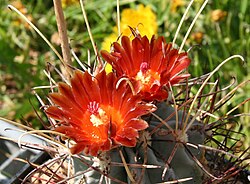Sclerocactus
| Sclerocactus subsp. var. | ||||||||||||||||||||||||||||||||||||||||||||||||||||||||
|---|---|---|---|---|---|---|---|---|---|---|---|---|---|---|---|---|---|---|---|---|---|---|---|---|---|---|---|---|---|---|---|---|---|---|---|---|---|---|---|---|---|---|---|---|---|---|---|---|---|---|---|---|---|---|---|---|

|
|
| ||||||||||||||||||||||||||||||||||||||||||||||||||||||
| ||||||||||||||||||||||||||||||||||||||||||||||||||||||||
Sclerocactus ("hard cactus", from Greek; refers to the hard, dry fruit) is a genus of cacti. It comprises about 15 species, the exact number depending on the authority. These species are very xerophytic. They are sometimes called 'fishhook cactus' or 'little barrels'.
They are ovoid to elongate cylindric, have rigid stems with tubercules that are ± coalesced into ribs, and are ± covered with spines that come out of the aeroles.[1] Most species have at least one hooked spine at each areole. Less often, species may not have hooks. These plants are found in higher elevation deserts such as on the Colorado Plateau, or in the Mohave Desert or the Great Basin. They are well suited to extremes due to lack of rainfall, hot summers and below freezing winters.
S. parviflorus is the most common species; its flowers are usually pink, but are yellow in a few areas (see photo) or, rarely, white or intermediate shades. S. polyancistrus is the ‘giant’ of the genus. Some species are quite rare and need considerable further study.
Cultivation
Propagation
Pests and diseases
Species
- Sclerocactus blainei
- Sclerocactus brevispinus
- Sclerocactus cloverae
- Sclerocactus glaucus
- Sclerocactus mesae-verdae
- Sclerocactus nyensis
- Sclerocactus papyracanthus
- Sclerocactus parviflorus
- Sclerocactus polyancistrus
- Sclerocactus pubispinus
- Sclerocactus scheeri
- Sclerocactus sileri
- Sclerocactus spinosior
- Sclerocactus uncinatus
- Sclerocactus wetlandicus
- Sclerocactus whipplei
- Sclerocactus wrightiae
The following genera have been brought into synonymy with Sclerocactus and this is commonly accepted:
- Coloradoa Boissev. & C.Davidson
- Toumeya Britton & Rose
Gallery
-
photo 1
-
photo 2
-
photo 3
References
- ↑ Sclerocactus. Flora of North America Online. http://www.efloras.org/florataxon.aspx?flora_id=1&taxon_id=129764. Accessed 17 December 2007.
External links
- w:Sclerocactus. Some of the material on this page may be from Wikipedia, under the Creative Commons license.
- Sclerocactus QR Code (Size 50, 100, 200, 500)
